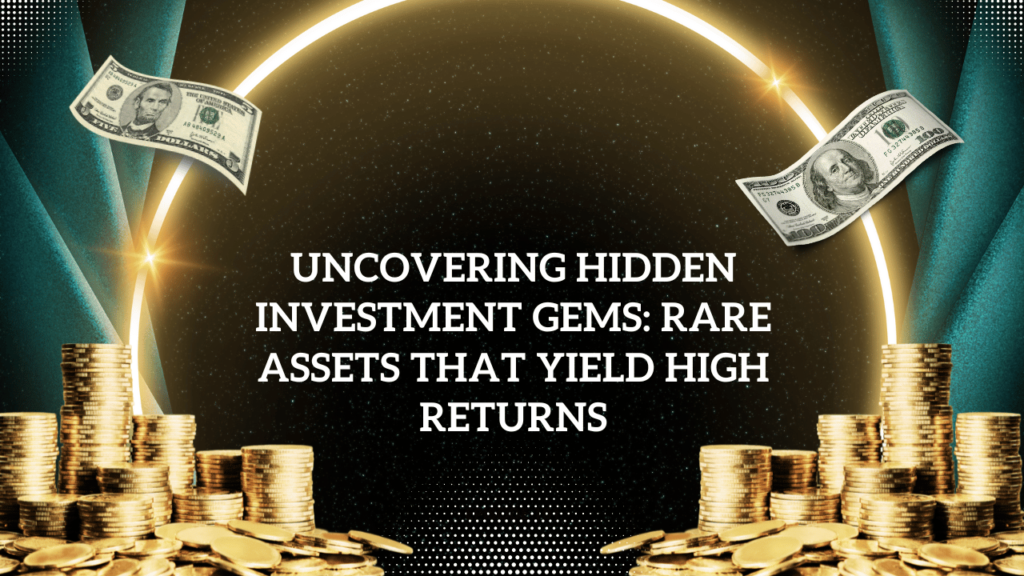In the realm of investment strategies, the allure of rare assets—often overlooked or undervalued—continues to attract astute investors seeking diversification and potential high returns. These unique investments, ranging from rare coins and fine wines to manuscripts and gemstones, offer distinct advantages beyond traditional financial instruments. By delving into these niche markets, investors can not only broaden their portfolios but also capitalize on assets characterized by scarcity, historical significance, and enduring cultural appeal. This blog explores the appeal, categories, considerations, and potential of these hidden investment gems.
The Appeal of Rare Assets
Rare assets possess intrinsic qualities that set them apart from more conventional investments like stocks and bonds. Their scarcity inherently drives up demand, fostering a market where supply dynamics play a pivotal role in determining value. Unlike financial securities, rare assets often hold tangible value beyond monetary metrics, encompassing historical provenance, artistic merit, or cultural significance. This dual appeal makes them resilient to economic downturns and attractive as long-term investments capable of weathering market volatility.
Exploring Diverse Categories of Rare Assets
Rare Coins and Collectibles
Investing in rare coins, stamps, artwork, and other collectibles is a pursuit that combines historical appreciation with financial potential. These items derive value from their limited production, historical context, and condition. Collectors and investors keen on acquiring rare coins or coveted artworks often find themselves participating in specialized markets where the rarity and uniqueness of items drive competitive bidding and price appreciation.
Fine Wines and Spirits
The market for fine wines and spirits offers a unique blend of connoisseurship and investment opportunity. Rare vintages from esteemed vineyards and limited-edition whiskies appeal to collectors and investors seeking alternatives to traditional financial instruments. Factors such as vineyard reputation, vintage quality, and global demand trends influence the value trajectory of these liquid assets, presenting opportunities for profit alongside the enjoyment of appreciating cultural and historic significance.
Rare Books and Manuscripts
Rare books and manuscripts provide a glimpse into literary history while offering potential for substantial financial returns. First editions, manuscripts of renowned authors, and historically significant documents are prized for their scarcity and cultural importance. Investors specializing in rare books navigate auctions and private sales with a discerning eye for authenticity and market demand, recognizing the enduring value these items hold within the realm of cultural heritage and investment potential.
Rare Gemstones and Minerals
Gemstones such as diamonds, emeralds, and sapphires captivate investors with their beauty and rarity. Beyond their aesthetic appeal, these gems are valued for their clarity, color intensity, and scarcity. Moreover, rare minerals essential for technological advancements, such as rare earth elements, offer strategic investment opportunities in commodities crucial to modern industries. Investors diversifying their portfolios with tangible assets often consider gemstones and minerals as a hedge against economic volatility and inflation.
Specialized Financial Instruments
For sophisticated investors, specialized financial instruments provide access to unique market opportunities beyond conventional securities. These instruments may include rare derivatives, structured products, or alternative investments tailored to specific risk-return profiles. By integrating these instruments into diversified portfolios, investors can potentially enhance overall returns while mitigating exposure to traditional market fluctuations.
Considerations for Investors
Investing in rare assets necessitates thorough research and consideration of several factors:
- Expertise: A comprehensive understanding of each asset class—from historical significance to market dynamics—is crucial for making informed investment decisions.
- Risk Management: Assessing liquidity, storage requirements, and regulatory considerations associated with rare assets is essential for prudent portfolio management.
- Long-Term Outlook: Rare assets often appreciate steadily over time, making them suitable for investors with a patient investment horizon and a commitment to enduring value.
Exploring hidden investment gems in rare coins, fine wines, manuscripts, gemstones, and specialized financial instruments presents opportunities for diversification and potential high returns. These assets not only enrich investment portfolios but also offer a deeper connection to history, culture, and craftsmanship. By embracing the unique opportunities presented by rare assets, investors can navigate today’s complex financial landscape with resilience and foresight.
As global markets evolve, rare assets stand as testament to the enduring allure of scarcity, rarity, and cultural significance. Whether driven by historical fascination, profit potential, or portfolio diversification, these hidden gems provide a compelling alternative to traditional investments and underscore the art of investing in assets that transcend mere financial gain.

